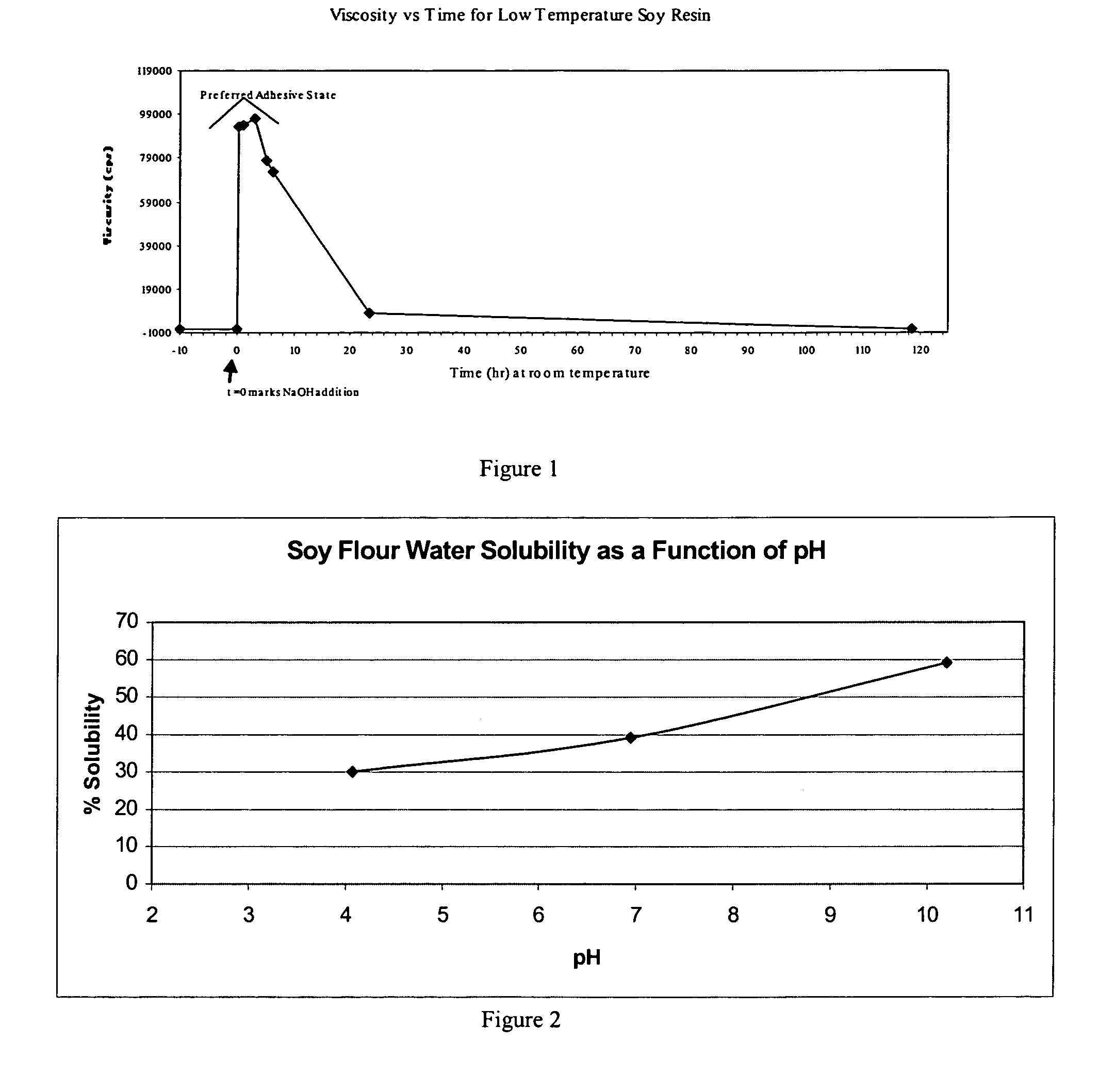Water-resistant vegetable protein powder adhesive compositions
- Summary
- Abstract
- Description
- Claims
- Application Information
AI Technical Summary
Benefits of technology
Problems solved by technology
Method used
Image
Examples
example 1
[0066] A powder soy resin was prepared by combining components in the order as listed in Table 1. This example was prepared to demonstrate the ability to produce a low temperature soy based powder resin that retains the properties of the “preferred adhesive state”. The resin contains only soy flour, water and denaturant (sodium hydroxide) with no cross-linking agent or additives.
TABLE 1SequenceIngredientAmount (g)% to Soy01Water154.302Soy Flour48.20350% NaOH9.610.0Total212.1
[0067] The preparation is a three-stage process as outlined below.
[0068] Stage I: To a 500 mL flask equipped with mechanical stirring, water was charged followed by the addition of soy flour at room temperature to form a semi-soluble solution / dispersion. The mixture was allowed to stir for 5 minutes to ensure homogeneity, after which the denaturant, sodium hydroxide, was charged drop-wise over 1-2 minutes to the rapidly stirring mixture. The mixture was allowed to stir at room temperature for 10 minutes. The v...
example 2
[0073] A reactive phenol-formaldehyde was prepared by combining components in the order as listed in Table 2. The reactive resin was later blended with a denatured soy flour mixture as shown in examples 3-5.
TABLE 2SequenceIngredientAmount (g)Moles to Phenol01Phenol 100%450.01.0002Formaldehyde 37%805.52.0803NaOH 100%53.60.1404NaOH 100%24.10.06Total1333.2
[0074] All of the phenol (1) and formaldehyde (2) where combined in a 2 L flask at room temperature. The solution was heated to 25° C. when 50% NaOH (3) was added drop-wise. The solution was then heated to 69-71 ° C. over 15 minutes using cooling to prevent over-heating and held for 1.0 hour. The remainder of the 50% NaOH (4) was then added drop-wise to the solution, while maintaining a temperature of 69-71° C. The solution was then heated to 84-86° C. over 15 minutes and held for an anticipated Gardner viscosity of “O-P”. The solution was cooled to 40° C. in a cold water bath over 10-15 minutes, filtered through a coarse screen and...
example 3
[0075] To improve the durability, mainly the water resistance of the powder adhesive from Example 1, some phenol formaldehyde cross-linking agent, as prepared from example 2, was added to a Stage I resin similar to example 1.
TABLE 3SequenceIngredientAmount (g)% to SoyStage I01Water214.302Soy Flour48.20350% NaOH33.835.1Stage II04Phenol Formaldehyde116.254.1Example 2Total412.5
[0076] Stage I: To a 1000 mL flask equipped with mechanical stirring, water was charged followed by the addition of soy flour at room temperature to form a semi-soluble solution / dispersion. The mixture was allowed to stir for 5 minutes to ensure homogeneity, after which the denaturant, sodium hydroxide, was charged drop-wise over 1-2 minutes to the rapidly stirring mixture. The mixture was allowed to stir at room temperature for 10 minutes. The viscosity of the adhesive quickly increased to afford a creamy, light brown adhesive mixture containing the soy in the “preferred adhesive state.”
[0077] Stage II: To the...
PUM
| Property | Measurement | Unit |
|---|---|---|
| Temperature | aaaaa | aaaaa |
| Temperature | aaaaa | aaaaa |
| Fraction | aaaaa | aaaaa |
Abstract
Description
Claims
Application Information
 Login to View More
Login to View More - R&D
- Intellectual Property
- Life Sciences
- Materials
- Tech Scout
- Unparalleled Data Quality
- Higher Quality Content
- 60% Fewer Hallucinations
Browse by: Latest US Patents, China's latest patents, Technical Efficacy Thesaurus, Application Domain, Technology Topic, Popular Technical Reports.
© 2025 PatSnap. All rights reserved.Legal|Privacy policy|Modern Slavery Act Transparency Statement|Sitemap|About US| Contact US: help@patsnap.com


